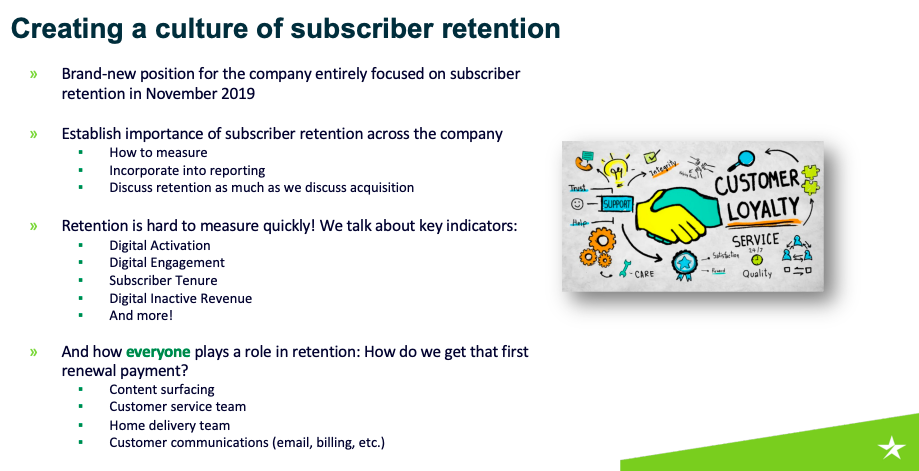
Newsletter
Newsletter
Using the Reuters Institute’s crystal ball, we look at what publishing leaders are expecting in 2023 including their business, platform and product plans.
19th January 2023

In the Pugpig weekly media bulletin, Pugpig’s consulting services director Kevin Anderson distills some of the best strategies and tactics that are driving growth in audiences, revenue and innovation at media businesses around the world.
When we spoke to publishing leaders for our State of the Digital Publishing Market report, we sensed that they were starting to shift gears. Yes, they still had a subscriber growth focus, but they also wanted to consolidate the gains that many of them had made during the pandemic. Underscoring this shift, a new report from Minna Technologies in partnership with FT Strategies found that of 50 subscription businesses that they surveyed, 68% said that retention was now their top priority. They said that the subscription economy is now entering the ‘retention era’.
Sign up to get the Media Bulletin in your inbox.
They define the first phase of the subscription economy as beginning roughly 20 years ago as subscriptions took hold across several industries, and second phase began as the COVID-19 pandemic ushered in a new phase of acquisition growth as people subscribed to numerous streaming services and digital transformation accelerated. Now, we are entering a new phase, they said.
What is the retention phase? For us at FT Strategies, we are noticing a pancaking effect, where the rapid growth observed through COVID is now being flattened by the subsequent effects of economic downturn and cost of living pressures on consumers.
George Adelman, Principal, FT Strategies
The report found that consumers have become much more aware of what they are spending on subscriptions as their budgets are squeezed by rising costs. The report found that 59% of UK consumers and 55% of US consumers know exactly how much they are spending on subscriptions. And consumers are jumping from subscription to subscription looking for the best deals and the best fit for their lifestyles. This will put a pressure on pricing, increase the importance of “intuitive UX experiences” and drive increased personalisation, Adelman said.
Flexibility plays a huge role in the subscription economy, and that 63% said that they would accept paying a higher monthly fee than being locked into an annual subscription. They also found that 25 to 35-year-olds have the largest number of subscriptions, seven or more, because they value “access, rather than ownership”. They switch subscriptions on and off as they need them, the report said.
Another finding that publishers should take note of: Consumers are looking for a single app to manage all of their subscriptions. Three-quarters of those surveyed said that they wanted this all-in-one subscription management service. Such a service particularly appeals to Gen Z and Millennial consumers, those aged 18 to 44, and they are interested in managing these subscriptions through a banking app rather than directly with the businesses that they subscribe too. They feel so strongly about this that they would be willing to switch to a bank that offered such a service. This is driving businesses to “co-create collaborative ecosystems”.
Other impacts of these economic and consumer shifts are leading businesses to seek retention solutions, with 60% of the businesses saying that they would pay for such solutions that would cut churn by 5%. Subscription businesses have found that offering discounts was the best way to prevent customers from churning, and that they are using data to “generate relevant and timely offers”. Moreover, there is an imperative to use data to improve their subscriber experience.
One thing to note, streaming TV and film services are the most common subs held by people, with 66% of people saying that they subscribed to them. For publishers, 13% of those surveyed said that they subscribed to magazines and 9% said that they had a subscription to a news service.
It’s a great report full of insights into the next phase of the subscription economy. Some of this is driven by economic headwinds, but it also comes from difficult lessons during the pandemic when publishers found that subscriber growth could come at the cost of revenue growth if their overall subscription strategies weren’t properly managed. Acquisition costs are always higher than retention costs, and if publishers focus too much on acquisition but don’t manage churn, it can erode customer lifetime value, as Digiday pointed out during the depths of the pandemic. This led to the paradox of subscription growth paired with revenue decline. This research underscores the challenges that publishers and other subscription businesses will need to manage as customers review their subs this year.
As if on cue, WAN-IFRA published an example of a publisher that has elevated retention to equal importance as acquisition, the Star-Tribune newspaper in the US. While the paper doesn’t get as much attention as the New York Times or the Washington Post, the regional paper based in Minneapolis, Minnesota is the third largest daily metro newspaper and the fourth largest Sunday title in the US. The paper introduced its paywall in 2011 and now boasts roughly 100,000 digital subscribers. The company expects to be a subscriber-first with most of its revenue from digital by 2027.
The company sharpened its focus on retention in 2019 when it created a full-time position, which is why some publishers might scoff at the idea that retention phase of the subscription economy only started after the pandemic. Instead, it might be more useful to view a retention focus as a measure of the maturity of a subscription business rather than a phase tied to market conditions or consumer behaviour.

Toby Collodora, the senior manager for retention and engagement, outlined how the newspaper created a culture of subscriber retention. As with any key strategic initiative, they developed ways to measure their retention efforts, which have become a key element in their reporting, and they have engaged the entire organisation in their retention efforts. Journalists understand the importance that their efforts play in retaining subscribers, and the retention focus has improved customer service and home delivery retention efforts as well.
To achieve their goals around digital activation and digital engagement, they make a lot of strategic use of email, Collodora said. They have long had an onboarding welcome series of emails that welcome new subscribers and promote their apps and their newsletters to keep subscribers engaged, she said. In addition to a welcome fro the editor, they added another welcome from their opinion editor that increased open rates and gave their engagement efforts “a substantial lift”, she said. They constantly test, measure and improve.
By identifying the key metrics that they track, they also identified a key lever in their retention efforts: getting subscribers to renew for the first time. “We talk about what each person in the organisation can do to get a subscriber to make that first renewal payment,” Collodora said.
One of the more counterintuitive efforts they launched was to create an online service to allow subscribers to cancel. Before the online service subscribers had to call, which gave the paper an opportunity to try to convince the subscriber to stay. There were concerns that this would make it easier to cancel, but they created a form in which the subscriber provided their name and email and answered a few questions about their subscription. They used this information to present an offer to the subscriber in the hopes that they would renew. The online service has reduced call centre volume, and the online save rate is 18.5% versus 8.8% for their call centre. And the online service has negligible impact – a 0.01% increase – on digital subscription cancellations.
Pugpig Consulting Services is working with clients to refine their acquisition and retention efforts by helping clients develop data models and reporting that provide key metrics to monitor, and we’re working with clients to improve their email engagement efforts by reducing effort and building automations. If you want to learn how we can help with your retention efforts, please get in touch with us at info@pugpig.com.
Here are some of the most important headlines about the business of news and publishing as well as strategies and tactics in product management, analytics and audience engagement.

Newsletter

Newsletter

Newsletter

Newsletter

Newsletter